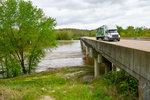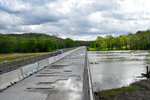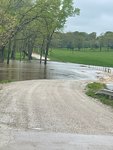MARIES COUNTY — Much of the business during last week’s Maries County Commission meetings dealt with roads and bridges and having adequate money to take care of them.
On Thursday …
This item is available in full to subscribers.
We have recently launched a new and improved website. To continue reading, you will need to either log into your subscriber account, or purchase a new subscription.
If you are a current print subscriber, you can set up a free website account by clicking here.
Otherwise, click here to view your options for subscribing.
Please log in to continue |
|






MARIES COUNTY — Much of the business during last week’s Maries County Commission meetings dealt with roads and bridges and having adequate money to take care of them.
On Thursday morning, following a large storm system that moved through the area, dumping three to five inches or more in parts of Maries County, the condition of county roads was a concern to the commissioners. There were roads underwater that morning and many washouts and road difficulties that it will take days or weeks to deal with, and also a lot of money.
Western District Commissioner said Road One workers were trying to “get things opened up.” He said MCR 219 had a big washout. He said the road workers were doing what they could.
Eastern District Commissioner Doug Drewel said MCR 409 was under water and he suspects the water was tearing up the road beneath it. Other roads with problems he mentioned were on MRC 408, 317, 454, 440, 450, 442 and more. He said anywhere where there is a creek, there are washouts. He said it will take $50,000 to fix them. Fagre said he thinks it will take $100,000 to fix the road problems in Road One following the heavy rain as the creeks are all up.
In Pulaski County a section of Highway U was washed away. It was reported that county received up to seven inches of rain in some places.
Presiding Commissioner Victor Stratman said there was a snag on the Wansing bridge and they will have to see what damage was done once the water goes down. It was reported there was heavy rain near Belle Chute as someone reported 4.9 inches of rain on Wednesday night and early Thursday morning.
They were bracing for additional flooding if more rain is received and were concerned the Gasconade River, too, would flood as a lot of rain fell south of the county, which is what pushes the Gasconade River into the floodplain. The National Weather Service was predicting between Saturday and Sunday, May 6 and 7 the Gasconade River would reach 24’4” at Jerome and 19’4” at Highway 89 in Rich Fountain.
Stratman said any repairs they make on the roads due to the flooding needs to be documented in the event a disaster is declared because of it. If so the county may qualify for disaster money, which may reimburse the road districts for the material and labor expenses it took to fix them.
Maries County has a number of bridges and low water crossing that need to be replaced, but it is expensive to do. In mid-March, Jeff Banderet, and engineer with Great River Engineering (GRE) of St. Louis, met with the commissioners and informed them of the Bridge Engineering Assistance Program (BEAP). It is a program that offers a way to get a free engineering report on the cost to fix or replace low water crossings, culverts, and bridges. The report is then used to pursue funding through grants or other sources. The cost of the report is paid for by MoDOT. The county owes nothing and gets a free engineering report.
At his last visit to Maries County, Banderet looked at a couple of Maries County bridges the commissioners are interested in getting replaced if there are programs available to help or completely pay for a bridge replacement project. Last week Banderet said he anticipates MoDOT will have the new Bridge Replacement Off-System (BRO) guidelines released in June. They have been told the new system will be a regional one. Maries County will be in a district and can apply for money. There will be a committee which will make the project selections. He said the committee will be made up of representatives of two regional planning commissions, some citizens, two MoDOT representatives, and two elected officials. This is the group that will decide on a district level which projects will be funded and move forward. Banderet said the county still will have a 20 percent match to meet with the BRO funding. But, the county can use American Rescue Plan Act (ARPA) money for the match.
Banderet talked about the Bridge Formula Program (BFP), which is part of the federal Bipartisan Infrastructure Law. This program pays for 100 percent of the bridge replacement cost and they hope to know more about the program in June as well. The projects all will be condition based and low water crossings are eligible as well as overhead bridges.
Also Banderet gave the commissioners a copy of the US Fish and Wildlife High Priority Aquatic Organism Passage (AOP) Crossings Priority Rank Passage Quality Index (PQI) on the Bourbeuse Watershed. The number one priority on this list is a crossing in Maries County over the Lower Peavine Creek on MCR 409. There were 19 Maries County priorities on the list. The Nature Conservatory has money available to replace low water crossings. The conservatory’s concern is for the fish and the availability of Aquatic Organism Passage (AOP). The concern is for the fish in the Bourbeuse Watershed, particularly the Niangua darter. Other Maries County crossings identified as having bridge infrastructure problems with blocking the ability of the Niangua darter to navigate the stream include MCR 432, 447,431, 408, 407, 422, Holt Road, 449, 419, 440, 411, 317, 313, 442, 424, 315, 414, and Route P.
Maries County is in MoDOT’s Central District and would compete with counties in the district for funding. The counties include Howard, Cooper, Boone, Moniteau, Callaway, Cole, Osage Maries, Miller, Morgan, Camden, Laclede, Pulaski, Phelps, Dent, Crawford, Washington and Gasconade.
The engineer told the commissioners the plan is for every county to have one bridge project slated for replacement. He had some plans for improving the crossing of MCR 409. Drewel said he wants to keep the same alignment as it has now, but to get the dam out of there. Banderet showed him Option number one, which is two 40 foot spans with a center pier, estimated to have a replacement cost of $480,000. He said this site is number one on the PQI list.
The engineer also had numbers for Fagre for replacing the bridge over Fly Creek on MCR 213. A 100 foot long span was estimated to cost $796,000. A two-span bridge with a center pier is estimated to cost $750,000.
Banderet asked the commissioners to put a priority list together.
He also asked them to go back about five years to see if the county still has paperwork needed documenting the bridge work they’ve done. This can be used toward the county’s BRO soft match. County Clerk Rhonda Rodgers said she will have to see how far back the county has records for that. It should quality as long as it is expenses the road districts had with replacing bridges. It can be a bridge rehabilitation, too, but that work must have had to get rid of all deficiencies of the bridge.
Drewel said he thinks for the MCR 409 bridge replacement project, it may be best to go through the Nature Conservatory. In June MoDOT will let everyone know more about the program, the engineer said. Stratman said if that PQI list is important to them, maybe the 409 project will qualify. Drewel said 409 is a poor crossing. People get trapped in because they can’t get out of the bottom land.
Floods getting higher
At the meeting following the visit of MRPC Assistant Director Tammy Snodgrass, who informed the commissioners about proposed changes to the county’s floodplain ordinance, there was additional conversation.
Drewel had concerns about raising by one foot the Base Flood Elevation (BFE). Stratman said if the county commission does not pass the floodplain ordinance, people in Maries County will not be able to buy flood insurance. But, they have some time to consider it. Stratman went to the bank and talked to a representative about it as they know banks use the floodplain information when loaning money to buy property or build houses; it’s information the bank needs. Stratman was told if the parameters of the ordinance were changed, the bank would work within the new rules and “deal with it.”
Drewel asked why they can’t just keep the old policy rather than updating it. Stratman said, “Floods are getting higher.” Now the ordinance states the floodplain is one foot above the BFE and they want to change it to two feet. The new maps will bring in additional information.
Drewel wondered how many people will that take in. If someone wants to sell a farm and the next guy might not one to buy it because of the encroachment of the floodplain. Stratman countered that maybe two years down the road the farm will flood and they won’t have any flood insurance. He said the new maps are coming and people who build in the floodplain will have to get a permit.
Drewel said going from one foot to two feet will take in a long way across the bottomland. He said if they don’t have to raise it that additional foot, he’s in favor of the BFE staying the way it is now. Stratman said it deserves talking about.
Deputy salaries
The Gasconade Valley Enterprise Zone (GVEZ) met at the Maries County Bank in Vienna recently. Stratman reported Maries County members attending were Bonnie Prigge, Ray Schwartze, Lloyd Honse, Kelly Barnhart and himself. There were three people from Osage County and one from Gasconade County.
Some of the conversation was about how Gasconade County is having difficulty getting sheriff’s deputies. They have talked about paying tuition for the people to get the necessary training and certification, and paying them $14 an hour for eight hours a day to go to the training. The county will require a three-year work commitment to Gasconade County Sheriff’s Office.
Fagre said Cole County starts road deputies at $42,000 a year. Maries County pays $22,000 annual salary but this is added to by the state’s deputy pay supplement program, which boosts them to $30,000 annual salary. Stratman commented it is expensive to outfit deputies.
He said Lloyd Honse is getting off of the GVEZ.
Fish Hollow
The commissioners briefly discussed the Fish Hollow Gasconade River Access and that at one time the road to the river access was Special Road District Four. At some point the county accepted it. Drewel asked, “How did any county road become on.”
“We’ve maintained it,” Stratman said.
Drewel said the Fish Hollow Hunting and Fishing Club’s lease did not include the river access. There was an old cabin there that burned, which was the club’s place. There is a deep ditch and a walking bridge that crossed to the cabin.
Drewel said this Fish Hollow road closing lawsuit also makes him wonder if they let one man control a road used by the public, will some people who have cemeteries on a dead end road try to close those roads, too. Public access to a cemetery could be lost in the same way.